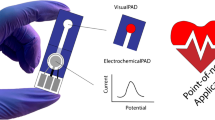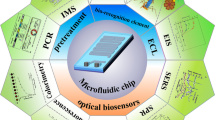Abstract
A fluorometric assay is described for the detection of the food pathogen Pseudomonas aeruginosa (P. aeruginosa). It is based on the hybridization of aptamer and fluorescein-labeled complementary DNA (FAM-cDNA) in combination with magnetic separation. In the absence of P. aeruginosa, FAM-cDNA is assembled on the surface of aptamer modified magnetic particles (MNPs) via hybridization between aptamer and cDNA. Upon addition of P. aeruginosa, FAM-cDNA is replaced by the bacteria and released from the MNPs since the aptamer preferentially binds to bacteria. After magnetic separation, the amount of bacteria can be quantified by determination of the fluorescence intensity (λexc/em = 494/525 nm) of the supernatant containing the released FAM-cDNA. This kind of assay allows for both selective enrichment and sensitive fluorometric determination of bacteria in a single step. The assay has a response to the logarithm of P. aeruginosa concentration that is linear in the range between 10 and 108 cfu·mL−1, with a detection limit as low as 1 cfu·mL−1. The detection process can be finished within <1.5 h. The feasibility of the assay was verified by detecting P. aeruginosa in spiked food samples.

Hybridization of aptamer and carboxyfluorescein labeled complementary DNA is combined with magnetic separation for detection of as low as 1 cfu·mL−1 Pseudomonas aeruginosa. This kind of assay allows for both selective enrichment and sensitive fluorometric determination of bacteria in a single step.





Similar content being viewed by others
References
Shi H, Trinh Q, Xu W, Zhai B, Luo Y, Huang K (2012) A universal primer multiplex PCR method for typing of toxicogenic Pseudomonas aeruginosa. Appl Microbiol Biotechnol 95:1579–1587
Aghamollaei H, Moghaddam MM, Kooshki H, Heiat M, Mirnejad R, Barzi NS (2015) Detection of Pseudomonas aeruginosa by a triplex polymerase chain reaction assay based on lasI/R and gyrB genes. J Infect Public Health 8:314–322
Krithiga N, Viswanath KB, Vasantha VS, Jayachitra A (2016) Specific and selective electrochemical immunoassay for Pseudomonas aeruginosa based on pectin-gold nano composite. Biosens Bioelectron 79:121–129
Kim LH, Yu HW, Kim YH, Kim IS, Jang A (2013) Potential of fluorophore labeled aptamers for Pseudomonas aeruginosa detection in drinking water. J Korean Soc Appl Biol Chem 56:165–171
Yu S, Yu F, Li Y, Liu L, Zhang H, Qu L, Wu Y (2016) Magnetic nanoparticles replacing microplate as immobile phase could greatly improve the sensitivity of chemiluminescence enzymatic immunoassay for deoxynivalenol. Food Control 60:500–504
Hendrickson OD, Chertovich JO, Zherdev AV, Sveshnikov PG, Dzantiev BB (2018) Ultrasensitive magnetic ELISA of zearalenone with pre-concentration and chemiluminescent detection. Food Control 84:330–338
Wang Y, Deng M, Jia L (2014) N-methylimidazolium functionalized magnetic particles as adsorbents for rapid and efficient capture of bacteria. Microchim Acta 181:1275–1283
Chen J, Lin Y, Wang Y, Jia L (2015) Cationic polyelectrolyte functionalized magnetic particles assisted highly sensitive pathogens detection in combination with polymerase chain reaction and capillary electrophoresis. J Chromatogr B 991:59–67
Tang Y, Zou J, Ma C, Ali Z, Li Z, Li X, Ma N, Mou X, Deng Y, Zhang L, Li K, Lu G, Yang H, He N (2013) Highly sensitive and rapid detection of Pseudomonas aeruginosa based on magnetic enrichment and magnetic separation. Theranostics 3:85–92
Jia F, Xu L, Yan W, Wu W, Yu Q, Tian X, Dai R, Li X (2017) A magnetic relaxation switch aptasensor for the rapid detection of Pseudomonas aeruginosa using superparamagnetic nanoparticles. Microchim Acta 184:1539–1545
Wu S, Wang Y, Duan N, Ma H, Wang Z (2015) Colorimetric aptasensor based on enzyme for the detection of Vibrio parahemolyticus. J Agric Food Chem 63:7849–7854
Wang J, Wu X, Wang C, Shao N, Dong P, Xiao R, Wang S (2015) Magnetically assisted surface-enhanced Raman spectroscopy for the detection of Staphylococcus aureus based on aptamer recognition. ACS Appl Mater Interfaces 7:20919–20929
Duan N, Wu S, Zhu C, Ma X, Wang Z, Yu Y, Yuan J (2012) Dual-color upconversion fluorescence and aptamer-functionalized magnetic nanoparticles-based bioassay for the simultaneous detection of Salmonella typhimurium and Staphylococcus aureus. Anal Chim Acta 723:1–6
Emrani AS, Taghdisi SM, Danesh NM, Jalalian SH, Ramezani M, Abnous K (2015) A novel fluorescent aptasensor for selective and sensitive detection of digoxin based on silica nanoparticles. Anal Methods 7:3814–3818
Chen L, Wen F, Li M, Guo X, Li S, Zheng N, Wang J (2017) A simple aptamer-based fluorescent assay for the detection of aflatoxin B1 in infant rice cereal. Food Chem 215:377–382
Li CH, Xiao X, Tao J, Wang DM, Huang CZ, Zhen SJ (2017) A graphene oxide-based strand displacement amplification platform for ricin detection using aptamer as recognition element. Biosens Bioelectron 91:149–154
Zhang Y, Wang S, Zhang Y, Pang G, Guo S (2017) Tuning the aggregation/disaggregation behavior of graphene quantum dots by structure-switching aptamer for high-sensitivity fluorescent ochratoxin a sensor. Anal Chem 89:1704–1709
Jin B, Wang S, Lin M, Jin Y, Zhang S, Cui X, Gong Y, Li A, Xu F, Lu TJ (2017) Upconversion nanoparticles based FRET aptasensor for rapid and ultrasensitive bacteria detection. Biosens Bioelectron 90:525–533
Wang KY, Zeng YL, Yang XY, Li WB, Lan XP (2011) Utility of aptamer-fluorescence in situ hybridization for rapid detection of Pseudomonas aeruginosa. Eur J Clin Microbiol Infect Dis 30:273–278
Xuan S, Wang YXJ, Yu JC, Leung KCF (2009) Tuning the grain size and particle size of superparamagnetic Fe3O4 microparticles. Chem Mater 21:5079–5087
Peleg AY, Tilahun Y, Fiandaca MJ, D’Agata EMC, Venkataraman L, Moellering RC, Eliopoulos GM (2009) Utility of peptide nucleic acid fluorescence in situ hybridization for rapid detection of Acinetobacter spp. and Pseudomonas aeruginosa. J Clin Microbiol 47:830–832
Wan Y, Zheng L, Sun Y, Zhang D (2014) Multifunctional semiconducting polymer dots for imaging, detection, and photo-killing of bacteria. J Mater Chem B 2:4818–4825
Kaur G, Raj T, Kaur N, Singh N (2015) Pyrimidine-based functional fluorescent organic nanoparticle probe for detection of Pseudomonas aeruginosa. Org Biomol Chem 13:4673–4679
Ellairaja S, Krithiga N, Ponmariappan S, Vasantha VS (2017) Novel pyrimidine tagged silver nanoparticle based fluorescent immunoassay for the detection of Pseudomonas aeruginosa. J Agric Food Chem 65:1802–1812
Chen Z, Sun M, Luo F, Xu K, Lin Z, Zhang L (2018) Stimulus-response click chemistry based aptamer-functionalized mesoporous silica nanoparticles for fluorescence detection of thrombin. Talanta 178:563–568
Lu S, Wang S, Chen C, Sun J, Yang X (2018) Enzyme-free aptamer/AuNPs-based fluorometric and colorimetric dual-mode detection for ATP. Sensors Actuators B Chem 265:67–74
Acknowledgements
We are grateful to the financial support of the National Natural Science Foundation of China (21675056) and the Scientific and Technological Planning Project of Guangzhou City (201805010002).
Author information
Authors and Affiliations
Corresponding author
Ethics declarations
The author(s) declare that they have no competing interests.
Electronic supplementary material
ESM 1
(DOCX 247 kb)
Rights and permissions
About this article
Cite this article
Zhong, Z., Gao, X., Gao, R. et al. Selective capture and sensitive fluorometric determination of Pseudomonas aeruginosa by using aptamer modified magnetic nanoparticles. Microchim Acta 185, 377 (2018). https://doi.org/10.1007/s00604-018-2914-3
Received:
Accepted:
Published:
DOI: https://doi.org/10.1007/s00604-018-2914-3




